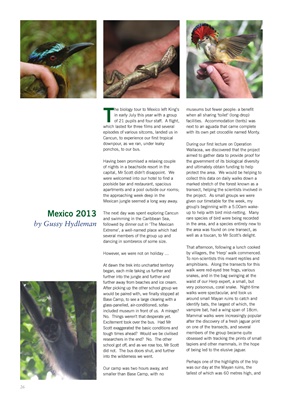
Mexico 2013
by Gussy Hydleman T
he biology tour to Mexico left King's
in early July this year with a group
of 21 pupils and four staff. A flight,
which lasted for three films and several
episodes of various sitcoms, landed us in
Cancun, to experience our first tropical
downpour, as we ran, under leaky
ponchos, to our bus.
Having been promised a relaxing couple
of nights in a beachside resort in the
capital, Mr Scott didn't disappoint. We
were welcomed into our hotel to find a
poolside bar and restaurant, spacious
apartments and a pool outside our rooms;
the approaching week deep in the
Mexican jungle seemed a long way away.
The next day was spent exploring Cancun
and swimming in the Caribbean Sea,
followed by dinner out in 'The Mexican
Extreme', a well-named place which had
several members of the group up and
dancing in sombreros of some size.
However, we were not on holiday …
At dawn the trek into uncharted territory
began, each mile taking us further and
further into the jungle and further and
further away from beaches and ice cream.
After picking up the other school group we
would be paired with, we finally stopped at
Base Camp, to see a large clearing with a
glass-panelled, air-conditioned, sofasincluded
museum in front of us. A mirage?
No. Things weren't that desperate yet.
Excitement took over the bus. Had Mr
Scott exaggerated the basic conditions and
tough times ahead? Would we be civilised
researchers in the end? No. The other
school got off, and as we rose too, Mr Scott
did not. The bus doors shut, and further
into the wilderness we went.
Our camp was two hours away, and
smaller than Base Camp, with no
museums but fewer people: a benefit
when all sharing 'toilet' (long-drop)
facilities. Accommodation (tents) was
next to an aguada that came complete
with its own pet crocodile named Monty.
During our first lecture on Operation
Wallacea, we discovered that the project
aimed to gather data to provide proof for
the government of its biological diversity
and ultimately obtain funding to help
protect the area. We would be helping to
collect this data on daily walks down a
marked stretch of the forest known as a
transect, helping the scientists involved in
the project. As small groups we were
given our timetable for the week, my
group's beginning with a 5.00am wakeup
to help with bird mist-netting. Many
rare species of bird were being recorded
in the area, and a species entirely new to
the area was found on one transect, as
well as a toucan, to Mr Scott's delight.
That afternoon, following a lunch cooked
by villagers, the 'Herp' walk commenced.
To non-scientists this meant reptiles and
amphibians. Along the transects for this
walk were red-eyed tree frogs, various
snakes, and in the bag swinging at the
waist of our Herp expert, a small, but
very poisonous, coral snake. Night-time
walks were spectacular, and took us
around small Mayan ruins to catch and
identify bats, the largest of which, the
vampire bat, had a wing span of 18cm.
Mammal walks were increasingly popular
after the discovery of a fresh jaguar print
on one of the transects, and several
members of the group became quite
obsessed with tracking the prints of small
tapiers and other mammals, in the hope
of being led to the elusive jaguar.
Perhaps one of the highlights of the trip
was our day at the Mayan ruins, the
tallest of which was 60 metres high, and
26